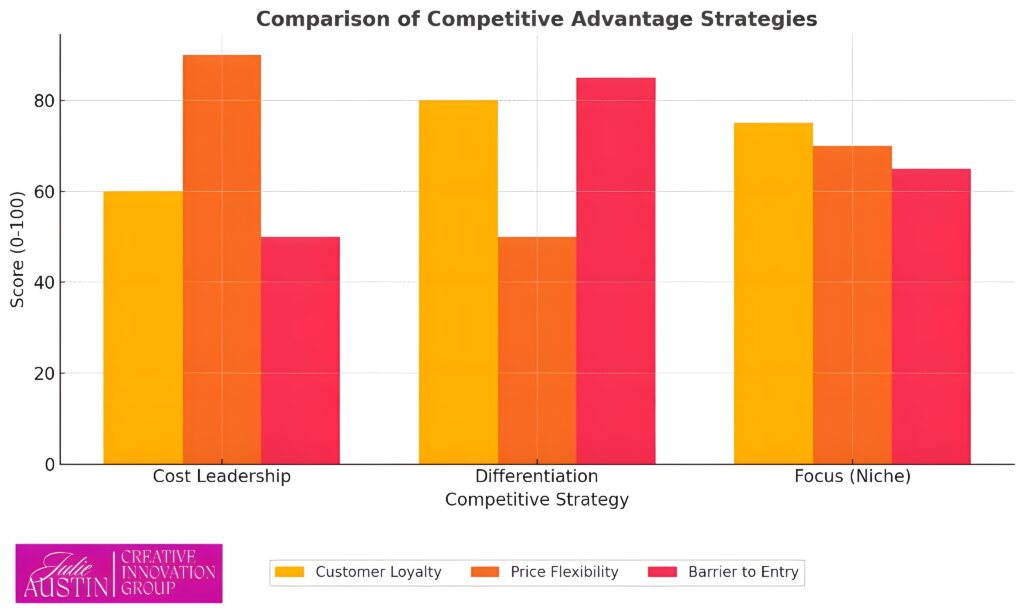Understanding Competition in Business and Gaining a Competitive Advantage
Competition in business drives growth, sparks innovation, and signals where you need to raise your game. It’s not just about beating others; it’s about learning from them, carving out your unique position, and creating value in a way that customers can’t get anywhere else. In this guide, we’ll explore every step—identifying rivals, analyzing their playbook, protecting your own secret sauce, and building a sustainable competitive advantage that keeps you ahead for the long haul.
Why Understanding Your Competition Matters
Competition isn’t a threat—it’s a teacher. When you truly understand your rivals, you:
- Anticipate market shifts. Early warning lets you pivot before trends leave you behind.
- Refine your value. You’ll spot what customers love and where you can do even better.
- Fuel innovation. Seeing others’ successes and missteps sparks ideas for new products, services, or ways of working.
Imagine you’re in a local coffee market saturated with chains and indie spots. A competitor introduces a drive-thru model that triples their morning sales. If you’d been monitoring their moves, you could have tested a similar approach or found a twist—like curbside pickups via an app—that resonates with your audience. Staying blind? You miss opportunities.
How to Identify and Analyze Competitors
Finding who you’re up against is only step one. Real analysis digs deeper.
- Map out direct rivals. These sell the same product or service and chase the same customers.
- Spot indirect competitors. Alternatives your customers consider—like choosing a home-brew kit instead of café coffee.
- Gather intel across channels.
- Websites & blogs: Compare messaging and featured products.
- Social media & ads: Look at engagement, ad offers, and messaging tone.
- Customer reviews: Note recurring praises or complaints.
- Pricing: Subscribe to promotions or mystery-shop online.
- Use frameworks like SWOT and Porter’s Five Forces. They give structure to your findings:
- Strengths and weaknesses of each competitor.
- Opportunities they haven’t seized.
- Threats posed by new entrants or substitutes.
Throw all this into a simple spreadsheet or free tool like Trello. Update it quarterly—or monthly if you’re in tech or e-commerce, where things move lightning fast. Over time, trends will emerge: product gaps, customer pain points, or areas where you can out-serve the competition.
Finding Your Competitive Advantage

A competitive advantage is your secret weapon—something you do better, cheaper, or differently than anyone else. There are three classic paths:
Cost Leadership
You streamline operations to deliver at a lower cost. Amazon built a distribution network so efficient they can undercut prices and still turn a profit. If you can match low prices without sacrificing quality, you capture price-sensitive shoppers and win market share.
Differentiation
Offer something your rivals can’t replicate easily—branding, design, exclusive partnerships, or proprietary tech. Apple’s sleek hardware and integrated ecosystem justify premium prices, building fierce loyalty.
Focus (Niche Specialization)
Own a niche by solving very specific problems. A boutique marketing agency specializing in eco-friendly brands will attract clients who need that exact expertise—clients a generalist agency might overlook.
Real-World Example
In the athletic footwear market, Nike leads on innovation (differentiation), Walmart offers budget-friendly alternatives (cost leadership), and smaller brands like On Running emphasize unique cushioning tech for serious runners (focus). Each found its lane and dominated.
Read: Top Examples of Competitive advantage
Trade Secrets: Keeping Your Edge Under Wraps
If you have processes, formulas, or data that give you an edge, keep them secret—and protected. Trade secrets need no registration, but the law requires reasonable measures to maintain confidentiality:
- Label: Stamp documents or digital files as “Confidential.”
- Secure: Store paper records in locked cabinets; use strong permissions and encryption for digital files.
- Restrict: Only give access to team members who absolutely need it.
- Agree: Have employees and partners sign non-disclosure agreements (NDAs).
Consider your pricing algorithm or a proprietary training program. If competitors get their hands on it, they can replicate your advantage overnight. Trade secret protection is your silent shield.
Pro tip: Use tiered access controls—different levels of secrecy for different data sets. That way, a breach in one area doesn’t expose everything.
Simple Competitive Intelligence Tactics
Competitive intelligence doesn’t require a fortune in software. Here’s how to get started:
- Set Google Alerts: Track competitor mentions in news, blogs, and forums.
- Sign up for their emails: You’ll receive the same deals, newsletters, and updates as customers.
- Analyze job postings: New roles hint at upcoming initiatives—if they’re hiring data scientists, they might be launching a new analytics platform.
- Monitor social ads: Tools like Facebook Ad Library let you see active campaigns.
- Leverage free analytics: Use BuiltWith or SimilarWeb to estimate their site traffic and tech stack.
Document your findings weekly, then distill insights monthly. Over time, you’ll connect the dots between strategy changes and results.
Innovation: The Lifeblood of Lasting Advantage
Innovation isn’t a one-off event; it’s a habit. Companies that embed innovation into their culture see consistent growth.
Steps to Foster Innovation:
- Brainstorm rituals: Set 30-minute sprints where any idea—no matter how wild—is welcome.
- Fail fast, learn faster: Encourage small experiments, celebrate both wins and lessons.
- Cross-functional squads: Blend marketing, R&D, and customer support to spark diverse thinking.
- Customer co-creation: Invite top clients to beta-test new features or products.
- Innovation champions: Appoint internal advocates who keep the momentum alive.
At Creative Innovation Group, Julie Austin illustrates how simple daily rituals—like a five-minute “what if?” session—can lead to game-changing breakthroughs.
Case in point: A software firm held weekly “bug hunts” where non-engineers suggested interface tweaks. One suggestion led to a 20% drop in user drop-off on the signup page. Small tweaks, big impact.
Patents vs. Trade Secrets: Choosing the Right Path
When you develop an invention, decide whether to patent or keep it secret:
- Patent:
- Pros: Exclusive rights for up to 20 years, legal recourse against infringers.
- Cons: Publicly disclosed, pricey, and time-consuming.
- Trade Secret:
- Pros: Indefinite protection if kept secret, no registration cost.
- Cons: Once leaked, you lose protection; proving misappropriation can be tricky.
Hybrid approach: Patent the core concept, then guard implementation details as trade secrets. This maximizes protection and flexibility.
Common Pitfalls and How to Avoid Them
Even successful companies can stumble. Watch out for these missteps:
| Pitfall | How to Avoid |
|---|---|
| Complacency | Schedule quarterly competitor audits and strategy reviews. |
| Leaking IP | Conduct regular security audits and reinforce NDA policies. |
| Stagnant culture | Rotate teams through innovation workshops and hackathons. |
| Undervaluing data | Invest in analytics tools and train staff to interpret insights. |
| Ignoring disruptors | Track startups in your space and subscribe to industry news. |
Real-World Case Study: Small Change, Big Impact
A regional print shop was trapped in price wars, losing margin daily. Instead of slashing fees, they launched an online portal that let clients reorder, get instant quotes, track shipments, and request tweaks—all in under two clicks. No one else in the region offered that.
They treated the portal as a trade secret—access limited to IT and key account managers—and rolled it out quietly to top clients. Within six months, customer churn dropped by 30% and average order size rose by 15%. Their secret? Making the customer experience effortless.
Protecting Your Competitive Strategies
Your advantage is only as strong as your safeguards:
- Access control: Use role-based permissions in your CRM and document management systems.
- Employee training: Host annual workshops on confidentiality and data security.
- Exit protocols: Ensure departing employees return devices and review NDAs.
- Legal checks: Keep contracts, NDAs, and IP assignments up to date.
Creative Innovation Group’s clients often cite this multi-layered approach as the reason their breakthroughs stayed in-house.
FAQs: Quick Answers to Common Questions
1. What is competition in business?
Any company vying for the same customer’s attention, wallet, or loyalty—directly or indirectly.
2. How do I conduct competitor analysis?
List rivals, gather data on their offerings, pricing, marketing, and customer feedback, then look for gaps and white spaces.
3. Can a small business develop a competitive advantage?
Yes—small teams can move faster, try bolder ideas, and connect personally with customers.
4. Are trade secrets expensive to protect?
Not really—tracking who has access and using NDAs are low-cost measures that yield high ROI.
5. When should I consider a patent?
When your invention is easy to reverse-engineer, or you need strong legal rights to license or attract investors.
6. How often should I update my competitive strategy?
Monthly in fast-moving sectors; quarterly at minimum for steady markets.
7. What tools help with competitive intelligence?
Google Alerts, SimilarWeb, BuiltWith, social media ad libraries, and email subscription monitoring.
8. How do I spark innovation on a budget?
Run internal contests, use free collaboration tools, and set aside 10% of meeting time for creative thinking.
9. What if a rival steals my trade secret?
Document your protective measures, consult legal counsel immediately, and consider pursuing misappropriation claims.
10. How can I train employees on competitive awareness?
Share competitor wins/losses in team meetings, run role-play scenarios, and create a monthly “market intelligence” newsletter.
11. How do I choose between cost leadership and differentiation?
Assess your resources: if you can’t beat the big players on price, focus on unique offerings or niche expertise.
12. What are some common mistakes in competitive analysis?
Relying solely on public data, ignoring customer voice, and failing to act on insights.
13. Can I license my trade secrets?
Yes, under strict agreements—this can be a revenue stream if partners pay for access.
14. How does innovation tie into competitive advantage?
Innovation refreshes your edge continuously; without it, advantages erode.
15. Is monitoring social media considered corporate spying?
No—as long as you’re only using public data and not hacking or misrepresenting yourself.
Conclusion
Understanding competition in business is an ongoing journey, not a one-time project. By regularly mapping your rivals, protecting your unique strengths with trade secrets or patents, and embedding innovation into your culture, you’ll build a competitive advantage that lasts. Stay curious, stay vigilant, and let competition push you to be better every day.
Ready to supercharge your strategy? Explore Creative Innovation Group’s resources and start transforming competitive insights into growth.

